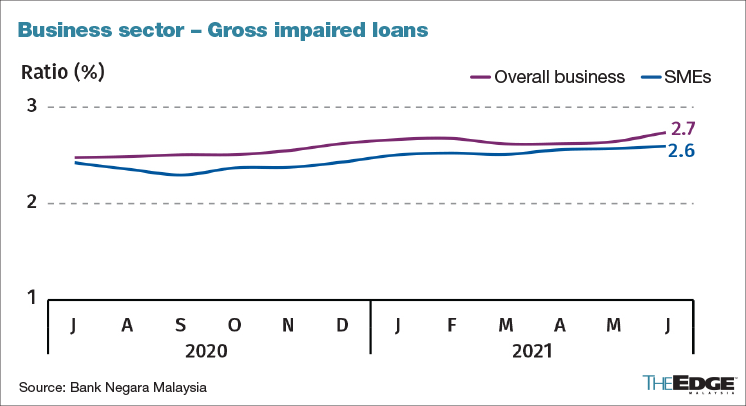
KUALA LUMPUR (Sept 29): Bank Negara Malaysia (BNM) said banks in the country expect to continue bolstering loan-loss provisions in the second half of 2021 (2H21) given renewed stress faced by some borrowers.
According to BNM’s Financial Stability Review report for 1H21, which was published on Wednesday (Sept 29), banks are preparing for higher loan-repayment defaults and have continued to build up provisions against the materialisation of potential credit losses when support measures are eventually unwound.
"Additionally, under a simulated scenario of an extended drag on the economy and the absence of policy interventions, banks are expected to remain resilient even if business [loan] impairments were to reach up to three times the current level by end-2022,” the central bank said.
BNM said banks' loan-loss provisions are likely to taper off with the return to more targeted loan-repayment assistance along with greater ability of banks to differentiate borrowers’ loan-repayment capacity as broad-based repayment assistance measures are gradually retired.
Loan growth is also expected to improve as Covid-19 containment measures are eased in tandem with the progress of the domestic vaccination programmes, according to BNM.
"This will provide further support to [banks'] earnings,” BNM said.
According to BNM, the expansion of loan-repayment assistance in November 2020 and again in June and July 2021 has kept the country's banking system impairments at low levels, with gross and net impaired loan ratios remaining stable at 1.6% and 1% of total loans respectively.
Notwithstanding this, banks have continued to increase loan-loss provisions for credit losses throughout 1H21 in anticipation of a deterioration in asset quality as loan-repayment assistance programmes are gradually unwound, BNM said.
"Total provisions are now about 54% higher than the pre-pandemic level at the end of 2019, and have risen further to 1.8% as a share of total loans as at end-June 2021 (2020: 1.7%; 5-year average: 1.3%).
"The loan-loss coverage ratio (including regulatory reserves) has remained around historically high levels at 129.2%,” BNM said.
Globally, BNM said most of the domestic banking groups’ overseas operations recorded an improvement in profitability, mainly due to lower loan-loss provisions made in 2021 compared to 2020.
In particular, operations in Singapore, which are the most significant, registered a strong turnaround in tandem with the recovery in economic activities as Covid-19 infections were effectively contained.
"Earnings from operations in Indonesia and Thailand were also lifted by a lower increase in impairment allowances. The overall performance of overseas operations was, however, weighed down by operations in Hong Kong, mainly due to higher provisions from additional management overlays allocated for borrowers with elevated credit risk.
"The improvement in earnings from both their domestic and overseas operations has enabled banks to preserve healthy capital buffers. This allowed some banks to cautiously resume dividend payments that were previously halted or reduced to conserve capital, although a number of banks have kept in place dividend reinvestment programmes to protect their capital buffers given lingering uncertainties over the outlook of the economy,” BNM said.


